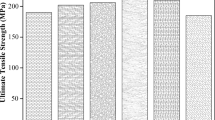Abstract
In this study, composite polymer-based materials were fabricated, in which a significant proportion of polyester resin was substituted by low-cost and environmentally-friendly clay-based raw materials. The main objective is to improve mechanical properties while maintaining a reasonable electrical insulating behavior. A homogenized distribution of fillers within the matrix compatible with the processing parameters was obtained up to a maximum added fraction of 20 vol%. Mechanical characterization using uniaxial traction tests and Charpy impact pendulum machine showed that stress-to-rupture can be enhanced of approximately 25 %. In addition, fracture energy was doubled for the best formulation. Dielectric constant was decreased and loss factor was slightly increased when electrical resistivity remained almost constant. In general, the composite materials with metakaolin fillers exhibited higher mechanical properties and greater electrical insulating behavior. Microstructural observation showed the presence of decohesive agglomerates of particles at the interface with the matrix. The mechanical properties were found to be more sensitive than electrical properties to the homogeneity of filler dispersion in the matrix.
Similar content being viewed by others
References
R. Thomas, D. Yumei, H. Yuelong, Y. Le, P. Moldenaers, Y. Weimin, T. Czigany and S. Thomas, Miscibility, morphology, thermal, and mechanical properties of a DGEBA based epoxy resin toughened with a liquid rubber, Polymer (Guildf), 49 (1) (2008) 278–294.
D. Devaprakasam, P. V Hatton, G. Möbus and B. J. Inkson, Effect of microstructure of nano- and micro-particle filled polymer composites on their tribo-mechanical performance, J. Phys. Conf. Ser., 126 (1) (2008) 012057.
J. Baller, N. Becker, M. Ziehmer, M. Thomassey, B. Zielinski, U. Müller and R. Sanctuary, Interactions between silica nanoparticles and an epoxy resin before and during network formation, Polymer (Guildf), 50 (14) 2009 3211–3219.
S. P. Bao, G. D. Liang and S. C. Tjong, Effect of mechanical stretching on electrical conductivity and positive temperature coefficient characteristics of poly(vinylidene fluoride)/carbon nanofiber composites prepared by non-solvent precipitation, Carbon N. Y., 49 (5) (2011) 1758–1768.
T. Tanaka, G. C. Montanari and R. Mulhaupt, Polymer nanocomposites as dielectrics and electrical insulationperspectives for processing technologies, material characterization and future applications, IEEE Trans. Dielectr. Electr. Insul., 11 (5) (2004) 763–784.
S. Deniel, N. Tessier-Doyen, C. Dublanche-Tixier, D. Chateigner and P. Blanchart, Processing and characterization of textured mullite ceramics from phyllosilicates, J. Europ. Ceram. Soc., 30 (2010) 2427–2434.
D. Buncianu, N. Tessier-Doyen, F. Courreges and J. Absi, Effect of thermal treatment of a clay-based raw material on porosity and thermal conductivity: experimental approach, image processing and numerical simulation, European Journal of Environmental and Civil Engineering}, DOI: 10.1080/19648189.2016.1164086
R. Podoba, I. Stubna, V. Trnovcova and A. Trnika, Temperature dependence of DC electrical conductivity of kaolin, J. Ther. Anal. Calorim., 118 (2014) 597–601.
S.-Y. Fu, X.-Q. Feng, B. Lauke and Y.-W. Mai, Effects of particle size, particle/matrix adhesion and particle loading on mechanical properties of particulate-polymer composites, Composites: Part B, 39 (2008) 933–961.
Y. K. Shchipalov, V. V. Makarov, T. V. Dubovik and T. A. Vasileva, Dielectric permeability of dehydrated kaolin of various chemical composition, Glass and Ceramics, 48 (1991) 809–883.
Author information
Authors and Affiliations
Corresponding author
Additional information
Recommended by Associate Editor Sang-Hee Yoon
Buncianu is a Ph.D. graduate from the Polytechnic University of Timisoara. During his Ph.D. studies, he made a training period of 24 months in the University of Limoges under the European Mobility Funding. He developed an expertise in the field of elaboration and characterization of clay-based material. Moreover, he associated the numerical modeling by finite element method to the characterization and validation aspects.
Joseph Absi is a senior member of the SPCTS laboratory of the University of Limoges at European Ceramic Center. He earned a Bachelor degree in Mechanical Sciences and Engineering from the Technical Institute of the University of Limoges. His fields of interest include numerical simulation based on the finite element method, particularly on thermal and mechanical properties of a wide variety of materials.
Rights and permissions
About this article
Cite this article
Buncianu, D., Tessier-Doyen, N., Courreges, F. et al. Mechanical and electrical properties of a polyester resin reinforced with clay-based fillers. J Mech Sci Technol 31, 1151–1156 (2017). https://doi.org/10.1007/s12206-017-0213-2
Received:
Revised:
Accepted:
Published:
Issue Date:
DOI: https://doi.org/10.1007/s12206-017-0213-2




